April 26, 2017
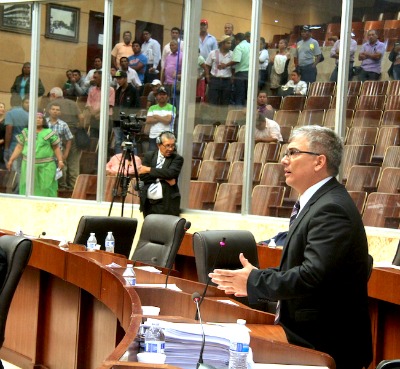
This is excellent news for the economy of Puerto Armuelles and its district of Baru.
It will also be good for many folks in Bocas del Toro.
Which is why all the Chiricanos and Bocatoreños deputies in the Legislature voted yes on it.
Our very own Porteño, deputy Carlos Motta (see photo) of the Democratic Revolutionary Party (PRD), was a major proponent for this bill. I hear he is very happy that jobs and more bananas are coming to Baru.
(Note: Baru is a district in the Chiriqui Province. Puerto Armuelles is the principal town in Baru)
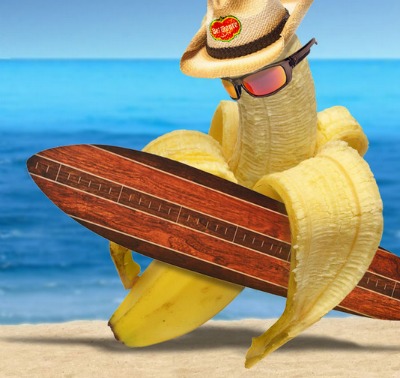
More Jobs
Jobs are why locals were so eager for Del Monte to get the final go ahead by the National Assembly.
More Bananas
The agreement requires that Del Monte put 900 hectares into banana production each year. (Note: the banana fincas are mostly located in the hills above Puerto Armuelles.)
On average, a hectare of land produces 2,725 boxes of bananas a year.
This means alot more bananas. Maybe we will finally be able to find bananas for sale in Puerto Armuelles on a regular basis.
The Details
The Contract between the State and Banapiña details a "Banana Reactivation Project".
It includes:
The contract is for 20 years, and automatically extendable for another 20. However, its tax exemptions must be reviewed by the state after the initial 20 year term.
The 5804 hectares that Del Monte will lease include 4030 State-owned hectares and 1,774 hectares owned by individual owners (including Coosemupar) who will lease them to the State. The State in turn will sublease those 1774 hectares to Del Monte (aka Banapiña). There may be an option for Del Monte to buy those 1774 hectares in the future.
The land must be leased since 90% of the banana plantations are less than 10 kilometers from the border. Foreigners (like Del Monte) are forbidden by the Panamanian constitution to own titled land within 10 kilometers of the border.
Until very recently, there have been continual delays in Del Monte getting permission to grow bananas in Baru.
The Government has made promises & then broken them.
Some progress was made.
But then it was stuck.
The "by early 2017" promised deadline had come and gone.

In March & April 2017, Portaneos took to the streets over the delay.
They organized marches and other peaceful protests to put pressure on the government. They wanted the deal approved by the legislature so that Banapiña Panama, a subsidiary of Del Monte, could finally produce bananas in Puerto Armuelles and other parts of Baru.
The protests seems to have worked.
FYI - they voted yes on Bill 488, the contract between the State & Banapiña Panama to reactivate banana production in Baru
It is now fully approved!
Del Monte (Banapiña) can now start to grow and harvest bananas in Puerto's banana plantations and in other areas of Baru.
The negotiations have involved many factors and obstacles.
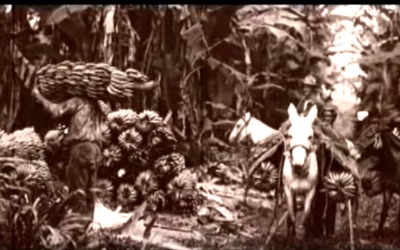
Puerto Armuelles was once synonymous with bananas. Starting in 1928, Puerto was built as company town. And it’s company was Chiquita Banana. Unfortunately, racism by the company and worker unrest lead to its workers striking and sabotaging Chiquita Banana’s crops.
Finally, in 2003, Chiquita sold its now unprofitable Puerto Armuelles banana business to a local cooperative, called Coosemupar. Due to a number of factors, Coosemupar was not successful, although it still limps along in a very limited fashion.
Chiquita's departure had a dramatic impact on Puerto Armuelles' prosperity and population. The town went from having close to 50,000 people to alittle more than 20,000 in 2010. The government has not done a census since 2010. But anecdotally, Puerto's population is more than 25,000 these days. Because even without a banana company, Puerto Armuelles's economy has been steadily improving over the last 5 years.
Adding Del Monte to Puerto Armuelles' economy will be a tremendous boost to its prosperity. Both Puerto and Del Monte have been counting on this. Del Monte has been in Puerto for awhile now getting things into place so they would be able to start work once they got the okay from the National Assembly.
It will be exciting to see what happens once the green gold of bananas is seen in the streets of Puerto Armuelles once again.
You can learn more about Puerto Armuelles by starting here.
Interested in living in our charming beach town? Check out our Puerto Armuelles real estate.
To learn more about the backstory of Del Monte coming to town on my site, read about the Minister of the Presidency, Alvaro Aleman, visit to Puerto Armuelles in July 2016. President Varela also touched on the status of Del Monte on his visit to Puerto in September 2016.
[leadplayer_vid id="58FF854299CB2"]
The video above was done by elsalvador.com
Tamborito evolved starting in the 17thcentury after the Spanish conquistadors brought slaves to Panama. The slave dance culture blended with the Mestizo (mix of Spanish and Indian) dances to establish a new dance. One that involved percussion instruments, clapping, singing, and lively choreography.
The dance is a romantic courtship between a man and a woman.
The basic choreography of the dance consists of shuffling steps. Every person who wants to dance creates a circle, men on one side and women on the other. Taking turns, one man and one woman will go into the center and dance with subtle movements of their hips and tiny steps. They may dance next to each other or face to face but never touching. Typically there are at least 6 couples dancing.
The male dancer works to impress the woman with fast footwork and by gesturing with his hat. He dances in a circular pattern- almost as if he is chasing her. The female dancer also moves in a circular pattern in accordance to the man. She holds her pollera (skirt) in both hands, letting the long fabric create a bell shape, as she moves gracefully as if gliding across the floor. At times the empolleradas provocatively swish their long flowing dresses. After inviting him closer in this way, she will spur him by turning her back and continuing her circling dance.
Professional Panamanian folk dancer Dimaris Bergeron says that eye contact is key to any Panamanian folk dance between a man and a woman. The woman is not supposed to smile because that would imply that she finds the man charming. It is a playful dance with the man trying to entice the woman while she resists his appeals.
The men are called montunos named after the straw hat that they wear. The women are called empolleradas named after their long skirt.
At the end of the dance, the partners curtsey to each other.
NOTE: The description of the dance above and the customs below are for the more staged and formal performances. Tamborito often occurs much more spontaneously or casually. Much like the video of Tamborito above.
Tamborito music incorporates Panama's African influences. Tamborito means “little drum”. The rhythm is referred to as “Tambor Norte”.
The Tamborito is played with three small drums, one for the high tones, one for the low tones (and a caja), another one for the rhythm. They layer their sounds on top of each other.
Depending on the region, it may also include a Spanish guitar, a violin and an almirez. The almirez is a metal mortar and pestle that is used as a percussion instrument. The instrument is historically Arabic.
There is usually one female lead singer who is supported by rhythmic chorus clapping and singing of the rest of the women. The lead singer, cantalante, may sing about life, work, or love, depending on the type of tamborito.
An important aspect of the dance is the costuming. Women wear La Polleras. A La Pollera is two separate pieces: a shirt and a Pollerón (long skirt). The gowns are detailed with colorful embroidery, lace, and ribbons.
On top of each female dancer’s head rests a large elaborate headdress called a tembleque.
The head decoration is almost as important as the dress itself. The hair is parted into two braids and tightly pulled back behind the ears. The head is decorated with tembleques. They are designed to sparkle. (see photo below).
The tembleques are applied with various types of combs. There can be as many as twenty combs on the head -ten per side. The woman also wears ornate and reflective jewerly (see photos below).
The men’s costume consists of a
There are different patterns of shirt, pants, and shoes, according to the region.
Click on photos to start slideshow.
The Tamborito is especially popular during the Panamanian Carnival, a national celebration that takes place between February and March, just before Lent begins.
Sources:
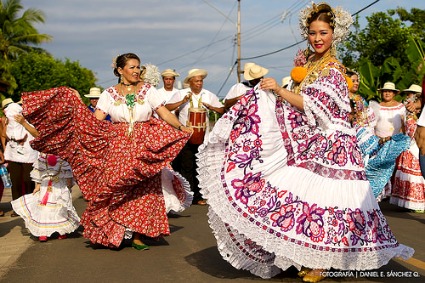
You can really feel the African influences in the music. El Tamborito is often performed at formal events, but I think it is best when it happens more causally.
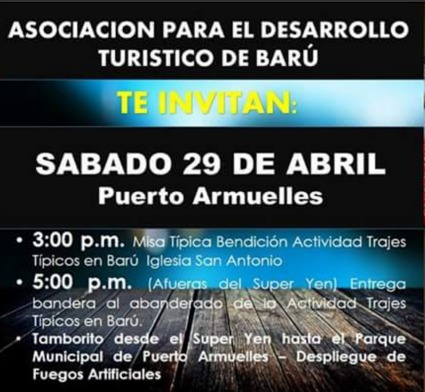
In Puerto Armuelles.
It will start at the San Antonio Church. The parade route is from Super Yen to the downtown municipal park (by the waterfront)
The Tourist Development Association of Baru is hosting this "First Parade of Tipica Costumes in Baru". (Note: Baru is a district in the Chiriqui Province.)
You can enjoy people from all over Baru dancing and singing and showing off their best tipica costumes
Saturday, April 29, 2017
The festivities & parade start outside of Super Yen. The parade ends at the Municipal Park (by the waterfront).
El Tamborito is just one of many folk dances in Panama. But this lively dance is unique to the country. As I said above, it is Panama's national dance. The dance symbolizes a romantic courtship between a man and a woman.
Tamborito music incorporates the African influences in Panama. Tamborito means “little drum”. The music consists of three drums that layer upon one another.
An important aspect of the dance is the costuming. Women wear la polleras. Polleras are are long white gowns with colorful embroidery, lace, and ribbons. On top of each female dancer’s head rests a large elaborate headdress. The men’s costume consists of a white loosely fitted shirt, trousers, and a straw hat.
At a casual event, people don't necessarily wear tipica customs. They also don't necessarily do the more formal dance style or dance much at all.
Click for more information on Tamborito dance, music, and costumes.
[justified_image_grid lightbox=photoswipe mobile_lightbox=photoswipe lightbox_max_size=large]
The weekends will be especially crowded. More than 300K visitors are expected this year. The David Fair has all sorts of things: horses, cows, car and tractor dealerships, plants, traditional dancing, and much more.
Handicrafts, Art, Furniture
If you are looking to buy some handicrafts, paintings, furniture, or hammocks is it worth your time to check out the stalls. There are both outdoor and indoor stands of a wide variety of merchandise.
Gardening
If you are a gardener, make sure you check out the area of the fair where they sell plants. There is an enormous variety of plants for sale. You may want to go during the day, when it is less crowded.
I believe admission still only costs $2 , $1 if you are retired. Admission is free if you are under 8 years old. If you want to see the "zoo", it is an extra 50 cents, which you pay at the zoo entrance.
I have written about the David Fair a few times in the past. If you are interested, here the links to those posts.
2012 visit including 2 hotel mentions
[leadplayer_vid id="58B33CE6847AD"]
We had fun, and bought a couple of different kinds of fish. Although, we were hoping to find a tuna that day, but no luck.
We love tuna, but it isn't popular here. Which is great for us. It is not popular so they sell it for only 60 cents a pound. Lightly seared and served with wasabi it is delectable.
Maybe next time they will have some tuna.
Where do you buy your fish in Panama?
We like to buy it off the boats. But people will walk or bike around with fish for sale.
We are alittle leary of buying non-iced seafood.
But if you go that route, here is a video that explains how to tell if a fish is fresh.
It is done by one of the YouTubers my daughter Blaise likes, Bart's Fish Tales. He also has alot of receipes for seafood of all sorts.
[leadplayer_vid id="58B33FE64858B"]
Please comment below

David is also conveniently located for day trips to visit Puerto Armuelles, Boquete, Volcan or Boca Chica, etc.
Sometimes even if you live in Chiriqui, you may want to stay the night in David. Those of us who live in Chiriqui, will go to David for all those items you cannot find anywhere else. Often, all those saved up errands turns into a very long day.
For example, if you are like us, you don’t drive to David very often. When we are in Seattle, we can run most of our errands in our own neighborhood. We don’t drive very much. Or, when we do drive, we take very short trips. We live a similar lifestyle in Puerto Armuelles. We can find almost everything we need, throughout the year, in Puerto. Everything from a very good grocery store, fresh fish and produce direct from the fisherman, or the farmer, to at least a half dozen building supply stores, to printing, copying, office supplies, etc.
We only go to David for things for some meetings or we sometimes need to buy parts for one of our cars that are not available at the frontera (Paso Canoas). There are also oversized (Architectural blueprint size) printers available in David. Full size plan sets are required for building permits in Panama.
There are 2 places to get oversized copies. Oficentro, a block east of the Central Park or Librereria Daisy, about two blocks north of Oficentro. (We are big fans of Oficentro. It sells a big assortment of art supplies, office supplies, jewelry, hair accessories and more.)
One of our David errands is PriceSmart. PriceSmart is Panama’s Costco.
We go there for various items, such as huge bag of dog food, Ghirardelli brownie mixes, frozen pizza, printer ink, Serrano ham, fresh mozzarella cheese, and more. When we go to PriceSmart, particularly if we are hungry and tired at the end of the day of errand running, we often come home with things that we really didn’t need. This is especially true because our family of 4 is more of cranky shopping committee at the end of a David trip, than a focused couple or single shopper.
PriceSmart is located on the highway Inter-Americana, 2 of kilometers south of the central part of David.
Occasionally, we have decided to spend the night in David after a long day of errands.
When we do our PriceSmart shopping trip that next morning we find we both don’t buy too much and don’t forget crucial items. The savings we gain from not over-shopping at Price Smart after a overly long day in David covers our hotel stay. So, a simple overnight stay in David can be good for family relations, even for one’s marriage. Amazing!
Plus you may find yourself needing to stay over night, or driving back the next day. Sometimes a meeting with a lawyer or notary in David, proves to be a 2-day thing.
The papers that were supposed to be available for signing quickly are not available. Or, the person running the agency where the papers are needed, suddenly remembers that there is one more “critical” document that needs to be signed in triplicate in order for a certain legal, bureaucratic process to move forward.
“Don’t worry: I’ll have the papers ready for you first thing in the morning”, says the smiling notary, or secretary, lawyer, etc.
We have all heard this on more than one occasion.
For those of us, who do not like to drive, the idea of driving all the way back home to Puerto Armuelles (1-1/4 hours, one way) only to turn around and do the trip again the very next morning, is well worth the $50, or $60 for a comfortable hotel. (Puerto Del Sol is an affordable & comfortable hotel in David)
The small capital city of our province does not provide much of an attraction for those of us living elsewhere in Chiriqui. However, it is occasionally necessary to make the trip to David.
By taking an extra half day to complete all of our tasks in David, we find we are much less stressed and tired. The trip is then even be enjoyable, or at least comfortable.
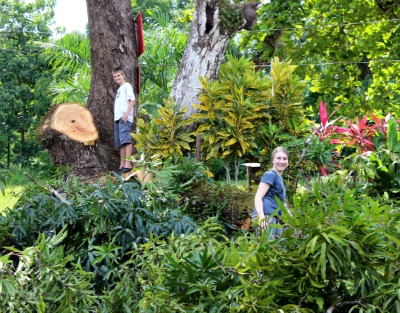
If you are Panamanian, you are much more likely to get away with it. Well, unless you have a neighbor who doesn't like you, or if the tree cutting damages your neighbor’s property.
It is the law.
Expats are expected to, and should, follow the letter of the law here. It is a sign of respect. A neighbor, or even a passerby, is much more likely to turn an expat into the authorities, than a local. Mostly, because it does seem disrespectful for foreigners not to follow the law.
You really do not want to gain a reputation for being someone who doesn’t respect the laws of your new country. It is a reputation that will only make your life more difficult.
Trees are considered a valuable resource in Panama. They are used for buildings and furniture. Their fruit and nuts are a valuable commodity as well.
And the reality is that deforestation is a real problem here. The climate of the Azuero Peninsula radically changed after they cut down most of their trees to expand cow farming. While your back yard trees are not part of the deforestation issue, the regulations to protect Panama's forests and tree resources, include you and your trees.
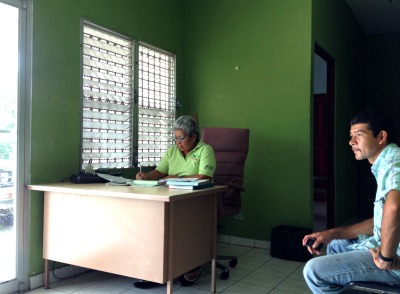
Panamanian law states that you must get a permit to:
You can request both permits at the same time.
You can be fined, if you cut down a tree without a permit. The more trees you cut down, the more you will be fined. Of course, someone has to complain for you to be fined.
The threat of fines does seem to keep people from harvesting trees for money, at least in areas where they are not likely to be seen felling a tree.
An Illegal Tree Cutting Experience. We had a neighbor, an expat, of one of our properties cut down 200 of our trees! The trees were all over 4" in diameter. We had planted them to block the sight of his cell tower. Unfortunately for him, the tees also blocked his ocean view.
While we were out of the country, without attempting to contact us, he decided to cut them all down. When we asked him about it, he claimed that his gardener said, "it was okay to cut them down". Yeah, it was the gardener's fault.
Although, we had ANAM come out and verify the number and size of the trees that he cut down, we did not press any charges. Given the number of trees, the fine would have been quite substantial. While were miffed and mystified about the incidence, but trees are easily grown here. So we decided to let it go. We simply replanted.
We have cut down a few trees in Panama over the years. Usually because the tree was in some way hazardous. For instance, when coconut palm trees get over a certain height, they are dangerous. A coconut falling from up high can kill someone.
Of course, we have also planted over ten thousand trees. We love both the ease of growing as well as the variety of trees here. We usually plant trees for shade, architectural interest, property boundaries, as well as fruit trees for their fruit.
Getting a tree removal permit is:
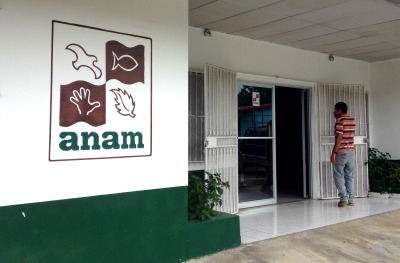
Required Documents
You must submit the following documents to your local ANAM office.
We typically ask our tree cutter to take his aserrador’s (logger) license to the ANAM (Environmental and Marine Administration) office to apply for the permits. We give him all the required documents above. It is much easier that way, as we discuss later in this post
You can apply for up to 5 trees to be removed per permit request.
ANAM in Puerto Armuelles: The ANAM office in Puerto Armuelles (see photo above) is 1 block south of the baseball stadium in Rio Mar neighborhood (on the same street as Pizza Pilo).
In addition, once you (or your tree removal guy) hands over all the required paperwork, you need to formally request an inspection of the property by an ANAM engineer.
The engineer usually comes out to visit the site very quickly: That day or the next. Then he returns to his office, fills out, signs, and stamps the permit.
So far, we have never had any request to fell trees on our property denied.
The property owner then goes to the ANAM office and pays the $13 permit fee. Make sure you leave with the permit in hand.
You then should give the permit to the person who is actually cutting down the tree.
Panamanian law requires that the tree felling permit be in the hands of the tree cutter, just in case of a surprise site inspection.
However, we have never had a follow up inspection in over 10 years of living in Puerto.
The whole process sounds arduous. In reality it is not.
Generally, this entire process can be accomplished in a day or two.
We have obtained our own permits many times.
We used to go to the office ourselves (well, Reyn usually went). Then it did feel arduous.
We find that having the guy who wants to do the tree removal (this applies to all kinds of contracts and contractors) apply for the permit himself, speeds the process up.
The worker knows the engineer. The engineer knows that the worker needs the work to feed his family. It makes it much less likely that there will be any bumps along the way. It is a “done deal”.
Of course, when we did it ourselves we never had a problem, though it did seem to take more time to get the permit. We don't want to discourage you from getting your own permits, but it is something to consider.
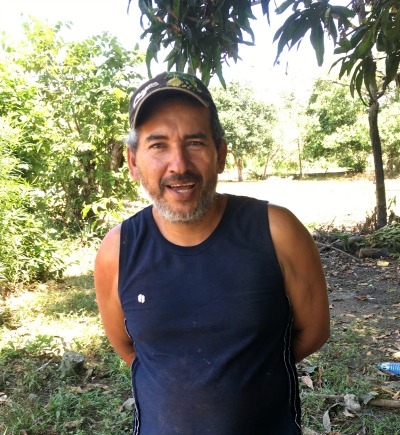
Our Tree Removal Guy - Lalo
Typically, we have Jose “Lalo” Samudio get the tree removal permit for us.
Lalo is a logger/tree remover here in Puerto Armuelles. Lalo is a licensed logger (“aserrador”). He also owns a tractor which is very helpful in the tree removal biz.
Lalo is also a competent woodworker, logger, backyard mechanic, and jack-of-all-trades. In short, Lalo is very handy guy to know. Plus, he has a lovely family, with a wife and three children.
In case you want to hire him, Lalo lives on a corner lot in the Coronado neighborhood, which is just north of the Corazon de Jesus neighborhood. Ask around and someone will point out his house.
Getting a permit will cost you $13 and about 2 days of waiting.
Most importantly, it helps you maintain good relations with both your neighbors and local officials.
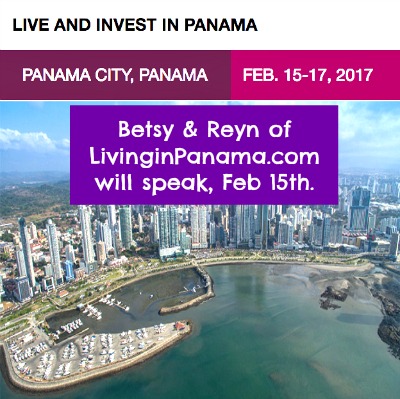
So, on Feb. 15, Reyn and I will share why and how we decided to live in Panama.
And, most importantly, what it is really like to live here in Panama.
The Live and Invest Overseas (LIO) literature about the conference is a bit over the top.
But it looks like the hype could be limited to getting people to attend the conference.
They even magnify the benefits of the accommodations. For instance, in their conference sales page, they state you save money because their special hotel rate includes free breakfast and free wifi. They assert "Internet alone can cost you US$30 a day at some hotels!" However, I have stayed in Panama City countless times and have never been charged for wifi, and almost always breakfast is included in my stay. You can see their sales page here.
However, in no way has LIO asked us to sugar coat or hype our presentation. They simply asked us to share what we would typically share about living in Panama.
So that is our plan. Our talk will be the straight scoop on our experiences moving to and living in Panama.
If possible I will tape our presentation and share it with you, our readers.
Our plan is to attend most, if not all, of the conference.
Neither of us have ever been to an event like this. I am very curious about what is presented and whether it seems realistic. Also, we want to be around to answer attendees questions.
I will write about our impressions when we return.
Although, we have never been to a LIO (or any) Panama conference, we have been in communication with them.
Back in 2013, 2 young men from Live and Invest Overseas came to do a report on our town, Puerto Armuelles. You can read about Live and Invest Overseas' visit to Puerto Armuelles, Panama.
Also, Reyn and I once interviewed Lief Simon of LIO via Skype about his Panama experiences. We put together a video in which he talks about the cost of living in Panama.
Have you been to a conference like this one before?
What was your experience? would you recommend it to a friend?
Please share in the comments below.
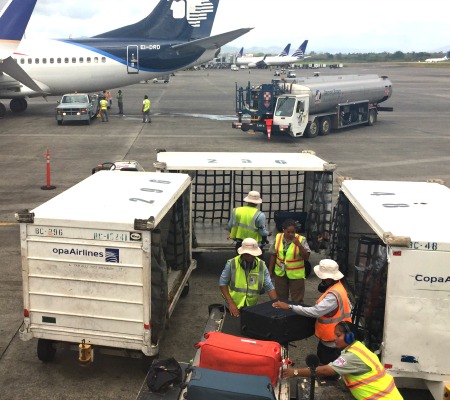
Include the David leg in your flight reservation.
Do not make a separate reservation for the Tocumen airport (PTY) to David leg.
FYI: Copa Airlines is the only carrier that flies from Panama City Tocumen International airport to David. You can find out more about flying from Panama City to David.
Normally, Copa allows you only 1 checked bag of 20 kilos (44 lbs) on its flight to David.
However, if you have a reservation through to David, Copa will abide by whatever baggage allowance your flight from outside of Panama allowed. Most airlines coming to Panama allow bags of up to 50 lbs and often allow up to 2 bags.
However, you must fly out of Tocumen airport within 24 hours of your plane's arrival in Panama City for the other flight's baggage allowance to be honored.
I hope this tip saves you some trouble and money.
If you are going to Puerto Armuelles from David, I have described how to get from David to Puerto Armuelles on my site.